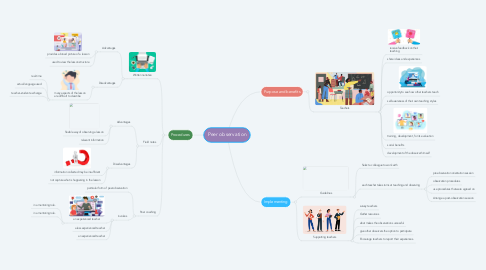
1. Procedures
1.1. Written narrative
1.1.1. Advantages
1.1.1.1. provides a broad picture of a lesson
1.1.1.2. used to view the lesson structure
1.1.2. Disadvantages
1.1.2.1. many aspects of the lesson are difficult to describe
1.1.2.1.1. real time
1.1.2.1.2. actual language used
1.1.2.1.3. teacher–student exchange
1.2. Field notes
1.2.1. Advantages
1.2.1.1. flexible way of observing a lesson
1.2.1.2. relevant information
1.2.2. Disadvantages
1.2.2.1. information collected may be insufficient
1.2.2.2. not capture what is happening in the lesson
1.3. Peer coaching
1.3.1. particular form of peer observation
1.3.2. involves
1.3.2.1. an experienced teacher
1.3.2.1.1. in a mentoring role.
1.3.2.1.2. in a mentoring role.
1.3.2.2. a less experienced teacher
1.3.2.3. an experienced teacher
2. Purpose and benefits
2.1. Teachers
2.1.1. receive feedback on their teaching
2.1.2. share ideas and experiences
2.1.3. opportunity to see how other teachers teach
2.1.4. self-awareness of their own teaching styles
2.1.5. training, development, for its evaluation
2.1.6. social benefits
2.1.7. development of the observer himself
3. Implementing
3.1. Guidelines
3.1.1. Select a colleague to work with
3.1.2. each teacher takes turns at teaching and observing
3.1.2.1. pre-observation orientation session
3.1.2.2. observation procedures
3.1.2.3. use procedures that were agreed on
3.1.2.4. Arrange a post-observation session
3.2. Supporting teachers
3.2.1. survey teachers
3.2.2. Gather resources
3.2.3. what makes the observation successful
3.2.4. give other observers the option to participate
3.2.5. Encourage teachers to report their experiences.
